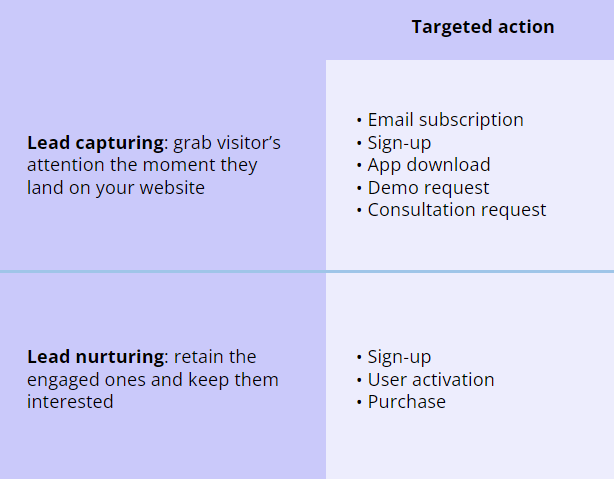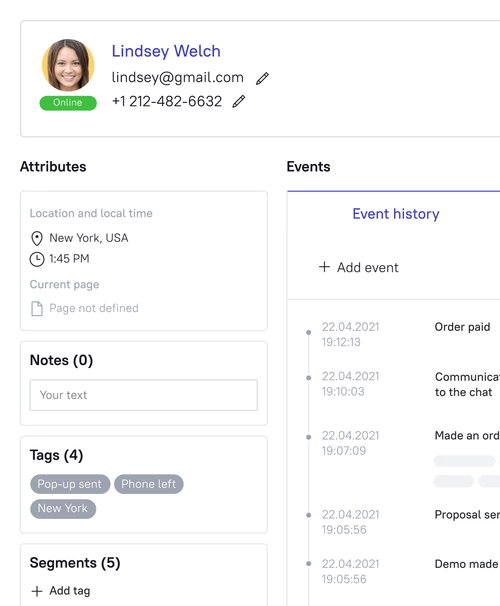What is sales led growth, and why does your business need it? [5 examples]
![What is sales led growth, and why does your business need it? [5 examples]](https://www.dashly.io/blog/wp-content/uploads/2023/08/What-Is-Sales-led-and-why-it-doesnt-work_-Expert-interview-1440x634.jpg)
The quest for sustainable business growth is a shared pursuit, but it often feels like an uphill battle, doesn’t it?
You’ve tried all the traditional growth strategies, and yet, the results are less than satisfactory. You’re constantly striving to make your marketing strategies more effective, but there’s always that elusive ‘something’ missing. That ‘something’, dear friends, could very well be a sales-led approach.
So, what is this ‘sales led’ phenomenon? And why should you care about it?
In the world where businesses are more customer-centric than ever, sales-led companies are redefining the rules of the game. They’re not just focusing on making a sale; they’re nurturing relationships, understanding customer pain points, and putting the customer at the heart of their growth strategy. They’re achieving unprecedented success, and it’s time you did, too.
In this article, we’ll delve into the world of sales-led growth, exploring its nuances, its impacts, and the critical role it could play in your business.
Ready to unlock a new level of growth for your business? Let’s dive in!
What is sales-led growth?
Sales-led growth, in its simplest form, is a business strategy where the sales function leads the growth of a company. Think of it like a dance where instead of marketing or product development taking the lead, it’s the sales team that’s calling the tune. They’re the ones setting the rhythm, guiding the steps, and ultimately, driving the performance of the dance, which in this case, is your business.
In growth sales-led companies, the sales team is right at the front lines. They’re the ones interacting directly with the customers, understanding their needs, and acquiring valuable insights. They use this knowledge to not just close deals, but to influence product development, refine marketing strategies, and shape overall business growth.
In essence, sales-led companies are harnessing the power of their sales team to drive growth, build better products, and deliver superior customer experiences. It’s a winning strategy that positions businesses for sustainable success in today’s customer-centric world.
What are the advantages of the sales-led growth?
Alright, let’s dig into the advantages of embracing a sales-led growth approach!
- Customer-centric: Sales-led companies are in the trenches with the customers. They understand customer needs and can respond quickly with solutions tailored to solve those needs. This direct interaction makes sales-led growth inherently customer-centric which makes it similar to customer-led growth.
- Agility and adaptability: The sales team’s insights can rapidly influence and shape the direction of a company’s growth strategies, making it more responsive to market changes.
- Increased revenue: By leading with sales, companies can often increase their revenue. By focusing on what the customer needs and closing deals, sales-led companies can often exceed their growth targets.
- Aligning teams: A sales-led approach can help align the entire company around the mission of customer satisfaction and growth. It ensures everyone, from product development to marketing, is working towards the same goal.
- Real-time feedback: Sales-led growth provides real-time feedback on products and services, which can be used to make immediate improvements.
In the end, both sales-led and marketing-led growth have their place in business strategy. But for businesses looking to drive quick, customer-centric growth, the sales-led approach offers some compelling advantages!
What are the downfalls of the sales led
It’s always vital to consider the flip side of the coin. While sales-led growth has many advantages, it also comes with its fair share of challenges. Here are a few to consider:
- Short-term focus: Sales-led growth can sometimes become overly focused on short-term goals. The drive to close deals and meet quotas may overshadow long-term strategic planning. It’s critical to strike a balance to ensure sustainable growth.
- Risk of neglecting brand building: In a sales-led growth model, there’s a risk of underestimating the importance of building a strong brand and long-term customer relationships. While improving sales funnel metrics is paramount, it’s equally important to engage in activities that foster brand loyalty and customer retention.
- Dependence on sales team: Lastly, a heavy reliance on the sales team may lead to a lack of autonomy or involvement from other departments. Sales-led growth should not mean sidelining other crucial functions like marketing or product development, but rather ensuring they work in harmony, guided by insights from the sales team.
Remember, every growth strategy, including sales-led growth, has its strengths and weaknesses. The key is to understand these and tailor your approach to align with your business goals and the needs of your customers.
Thanks! Here’s your copy of the growth strategy template

Sales-led vs Product-led growth
To truly understand the different pathways to growth, let’s dive into a comparison of sales-led and product-led approaches. They’re like two distinct routes to the same destination — business success.
Firstly, sales-led growth is like a guided tour, where the sales team takes the lead, interacting directly with customers, understanding their needs, and guiding them towards the company’s products or services. The sales team is the main driver of revenue, closing deals, and shaping the company’s growth strategy based on their insights from the frontline.
On the other hand, product-led growth is akin to a self-guided tour. Here, the product itself is the primary driver of customer acquisition, conversion, and expansion. It’s all about creating a product so good that it sells itself. Customers are attracted by the value the product offers, and their experiences with the product guide their decision to purchase or subscribe.
Now, let’s look at how these strategies can help businesses develop:
Product-led growth vs sales-led growth — in terms of business development, these two strategies have different strengths.
- Revenue generation: Sales-led growth can often generate revenue faster, as the sales team is actively closing deals. Product-led growth can take longer to generate revenue as it relies on users recognizing the value of the product over time.
- Scalability: Product-led growth can be more scalable. As the product improves and attracts more users, revenue can grow without the need for a proportionate increase in the sales team size. In contrast, sales-led growth often requires expanding the sales team to reach more customers and close more deals.
- Market responsiveness: Sales-led growth can be more responsive to market changes, as the sales team is continually interacting with customers and gaining insights. In contrast, product-led growth relies on user feedback and usage data, which may take longer to collect and analyze.
- Customer Acquisition Cost: Generally, product-led growth can have lower customer acquisition costs, as users are primarily attracted by the product rather than through sales efforts. However, this is not a hard and fast rule and can vary based on the product and market.
Remember, the choice between product-led growth vs sales-led growth isn’t always an either-or situation. Many successful companies use a blend of both, adjusting the balance as they grow and as market conditions change. The key is to understand your customers, your product, and your market, and choose the approach that best aligns with them.
5 successful examples of sales-led growth
There are numerous successful sales-led companies out there that we can learn from! Let’s dive into some shining examples of sales-led growth and see how businesses have used this approach to achieve remarkable results.
Oracle

This tech giant is a prime example of sales-led growth. Oracle’s sales team has been instrumental in deeply understanding customer needs and translating that into product offerings. Their sales-led approach has helped them maintain a dominant position in the competitive tech industry and consistently achieve impressive revenue growth.
Oracle employed a solution-selling strategy where their sales team focused on understanding the unique challenges of each client and offered tailored solutions. This approach allowed them to forge strong relationships with customers and increase their sales.
Salesforce

Salesforce is another star in the sales-led growth galaxy. Their sales team has always been front and center, communicating directly with customers, and driving revenue. This approach has been instrumental in propelling Salesforce to be a leader in the CRM space.
Salesforce’s strategy was built around the idea of “Customer Success”. Their sales team had a dual role — selling and ensuring customer satisfaction. They used tools such as Salesforce CRM to track customer interactions, manage sales pipelines, and provide personalized customer service.
IBM

IBM’s shift towards a sales-led approach has reaped significant benefits. By placing the sales team at the heart of their growth strategy, they’ve been able to adapt their offerings to better meet customer needs. This approach has played a critical role in IBM’s successful transition into areas like cloud computing and AI.
IBM’s sales team played a critical role in the company’s shift towards cloud computing and AI technologies. The sales team gathered customer insights and provided feedback to the technical team, influencing the development of new offerings. IBM also invested in training their sales team to understand and sell these complex solutions effectively.
SAP

SAP has long been a proponent of sales-led growth. Their sales team has been key in understanding customer challenges, influencing product development, and driving growth. This has enabled SAP to maintain its position as a leading provider of enterprise software.
SAP’s sales team used a consultative selling approach, where they worked closely with customers to understand their problems and then recommend the right SAP solutions. SAP also heavily invested in sales enablement tools and training to ensure their sales team had the skills and resources to sell effectively.
Cisco Systems

Cisco’s sales-led growth strategy has been a cornerstone of their success. By empowering their sales team to lead the way, they’ve been able to continually innovate and deliver solutions that meet evolving customer needs. As a result, Cisco is a respected leader in the IT and networking sector.
Cisco empowered their sales team to lead customer engagement and influence product development. They used tools like CRM to track and manage customer relationships, and also leveraged data analytics to identify sales opportunities and trends. Cisco’s sales team was trained to understand the technical aspects of their products, enabling them to sell more effectively.
These sales-led companies have harnessed the power of their sales teams to better understand customer needs, influence product development, and ultimately, drive impressive business growth. It’s a powerful reminder of the potential impact of a well-implemented sales-led growth strategy.
Read also:
- What is sales enablement? Definite guide + Strategy + Tools for 2024
- How to measure success: 20+ sales enablement metrics to track in 2024
- Harnessing the power of AI sales enablement: 5 strategies to transform your sales process
- 10 steps to building a sales enablement strategy in 2024
- 7-steps guide on how to create an automated sales funnel in 2024: examples & tools
- 7 sales enablement best practices to empower your team and boost performance
- 10 sales enablement tools: Best software to grow your team performance
- Guide on sales enablement team structure: 10 roles and responsibilities
- Mastering sales automation: A comprehensive guide to best practices and tools
- Sales and marketing automation: How to align their workflow to 2x revenue [Dashly example]
- Top 13 sales automation tools to propel your sales strategy
How to apply the sales-led growth strategy in your business
Understand your customers
The first step is to deeply understand your customers. Who are they? What are their pain points? What solutions are they seeking? You can gather this data through customer interviews, surveys, and market research.
Here, you’ll need tools like user behavior tracking in Dashly. It’ll monitor user activity on your website in real-time and collect valuable data within one lead card for further work.

Empower your sales team
Your sales team is the engine of your sales-led growth strategy. Equip them with the necessary training and tools to understand your product and effectively communicate its value to customers. Encourage them to build relationships with customers, not just close deals.
Leverage customer insights
Utilize the insights from your sales team to inform your business strategy. This includes product development, marketing strategies, and customer service improvements. Remember, your sales team is on the frontline with customers — they have a wealth of knowledge to share.
Implement a robust CRM
A robust CRM system is essential in a sales-led growth strategy. It helps manage customer relationships, track sales activities, and provide valuable data for decision-making. Dashly, for instance, offers lead scoring and segmentation, which can help prioritize sales efforts and personalize customer interactions.
Measure and adjust
Finally, establish clear metrics to measure the success of your sales strategies. This could include revenue growth, customer acquisition cost, and customer lifetime value. Be ready to adjust your strategy based on these metrics and any changes in the market.
Sales-led growth metrics
When creating a sales-led growth strategy, there are several key metrics you should keep a close eye on. These metrics will help you measure the effectiveness of your strategy and guide any necessary adjustments. Here they are:
- Revenue: This is the most straightforward metric, but it’s also the most critical. Track your revenue growth to measure the direct impact of your sales-led growth strategy.
- Sales Cycle Length: This refers to the average amount of time it takes for a lead to move through your sales funnel from initial contact to closing a deal. A shorter sales cycle often indicates a more effective sales strategy.
- Lead Conversion Rate: This metric shows the percentage of leads that convert into paying customers. A high conversion rate suggests that your sales team is effectively identifying and nurturing potential customers.
- Customer Acquisition Cost (CAC): CAC is the total cost of acquiring a new customer, including marketing expenses, sales team salaries, and any other related costs. Keeping your CAC lower than the lifetime value of your customers is key to a profitable sales-led strategy.
- Customer Lifetime Value (CLV): CLV is the total revenue you can expect from a customer over the duration of their relationship with your company. A high CLV indicates strong customer loyalty and repeat business, which is a positive sign for your sales-led growth strategy.
- Sales Team Efficiency: This can be measured in different ways, such as the number of deals closed per sales rep or the revenue generated per sales rep. It helps you assess the productivity and effectiveness of your sales team.
- Churn Rate: This is the percentage of customers who stop doing business with you over a given period. A lower churn rate suggests that your sales team is not only good at acquiring customers but also at retaining them.
By paying attention to these sales-led growth metrics, you can ensure that your strategy is on the right track and make data-driven decisions to drive your business growth.
Sales led growth best practices
Implementing a sales-led growth approach requires strategic planning and execution. Here are some best practices to guide your journey:
- Leverage Automation Tools: Use automation tools to streamline your sales process and improve efficiency.
Capture contacts and qualify leads before the meeting with a chatbot!
It will ask all the basic questions for you to pick the most suitable option for a prospect and personalize your offer.
Here’s an example of a qualification chatbot from our EdTech customer EDPRO 👉

- Prioritize Customer Relationships: A successful sales-led growth strategy is built on strong customer relationships. Prioritize customer satisfaction and work on building long-term relationships, not just closing one-time deals.
- Use Data-Driven Decision-Making: Use sales metrics to make informed decisions about your sales strategy. Track key metrics like revenue, sales cycle length, lead conversion rate, and customer lifetime value to measure the effectiveness of your strategy and identify areas for improvement.
- Align Sales and Marketing: Ensure your marketing and sales teams are aligned and working towards the same goals. They should share insights, collaborate on strategies, and support each other to drive business growth. Find out how to stop the battle between sales and marketing in our article.
- Keep Adapting: The business landscape is always changing, and so should your sales strategy. Be ready to adapt your strategy based on market changes, customer feedback, and sales performance.
Btw, you can always automate feedback collection with a chatbot!
It can be:
- Reviews on new features the product team launched;
- Satisfaction surveys;
- NPS surveys etc.

By following these best practices, you can implement a successful sales-led growth strategy that drives revenue, improves customer satisfaction, and propels your business growth. Remember, it’s a journey, not a destination. Keep learning, keep improving, and keep growing!
Wrapping up…
Navigating the path to business growth can often feel like a complex puzzle. However, as we’ve discovered, a sales-led growth approach could be the missing piece you’ve been searching for. By putting your sales team at the forefront of your growth strategy, you can tap into their unique insights, forge stronger customer relationships, and ultimately, drive impressive business growth.
Implementing a sales-led growth strategy requires a shift in mindset, a focus on key metrics, and a commitment to continuous improvement. But, with the right approach and the right tools, it’s a journey that can lead to remarkable results.
Speaking of the right tools, platforms like Dashly can be instrumental in your sales-led growth journey. From tracking customer behavior and collecting user data to managing lead scoring and segmentation, Dashly offers the features you need to empower your sales team and drive your sales-led growth strategy.
FAQ
What is sales-led growth?
In a nutshell, sales-led growth is a business strategy where the sales function takes the lead in driving the growth of a company. This means that the sales team is at the forefront, directly interacting with customers, understanding their needs, and using this knowledge to influence product development and shape overall business growth.
How does sales-led growth differ from marketing-led growth?
While marketing-led growth focuses on generating brand awareness and engagement, sales-led growth is centered around directly driving revenue. It involves the sales team actively closing deals, building customer relationships, and using their frontline insights to influence business strategy.
What are product-led sales?
Product-led sales is a strategy where the product itself drives customer acquisition and expansion. This typically involves offering a high-quality product with excellent user experience and then leveraging its value to convert users into paying customers.
What are the benefits of a sales-led growth strategy?
Sales-led growth can offer several benefits, including a customer-centric approach, increased revenue, better adaptability to market changes, and alignment of various teams towards a common goal. However, it’s important to note that the effectiveness of a sales-led growth strategy can vary depending on the specific circumstances of your company.
Which approach is better: sales-led or product-led growth?
The choice between sales-led and product-led growth largely depends on your business model, market, and specific goals. Both approaches have their strengths, and many successful companies use a blend of both, adjusting the balance as they grow and as market conditions change.
Read also:
- RevOps tech stack: guide to the best tools
- Revenue operations metrics: 10 metrics and KPIs to track your performance
- Product led growth metrics: 13 key indicators for SaaS companies to track
- PLG tools: ultimate guide to the best instruments
- Top 10 product led growth software your competitors use in 2023
- Benefits of Product led growth: 12 PLG benefits for your business
- 10 product led growth companies that boost their development right now
- Growth marketing case studies: 12 stories with detailed tactics and numbers achieved
- RevOps best practices: 13 tactics to implement this year
- 20 AI sales tools: Boost your sales strategy with revolutionary technologies
- Guide to sales funnel optimization: best tips, tools, and common pitfalls
- 10 inspiring sales funnel examples to boost your business growth





![The ultimate guide to growth marketing in 2025 [explained by a growth hacker]](https://www.dashly.io/blog/wp-content/uploads/2023/04/The-ultimate-guide-to-growth-marketing-explained-by-a-growth-hacker-720x317.png)
